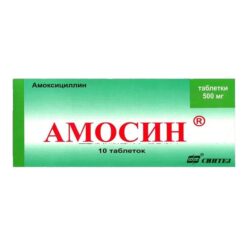No products in the cart.
Amosin, tablets 250 mg 10 pcs
€0.91 €0.76
Out of stock
(E-mail when Stock is available)
Description
A broad spectrum antibacterial bactericidal agent of the group of semisynthetic penicillins. It inhibits transpeptidase, disrupts synthesis of peptidoglycan (support protein of cell wall) during division and growth, causes lysis of bacteria.
Active against aerobic gram-positive bacteria: Staphylococcus spp. (except penicillinase-producing strains), Streptococcus spp; and aerobic gram-negative bacteria: Neisseria gonorrhoeae, Neisseria meningitidis, Escherichia coli, Shigella spp, Salmonella spp., Klebsiella spp.
The microorganisms producing penicillinase are resistant to the action of amoxicillin. The action develops 15-30 minutes after administration and lasts 8 hours.
Indications
Indications
Bacterial infections caused by susceptible microflora: Infections of the respiratory tract and ENT organs (sinusitis, pharyngitis, tonsillitis, acute otitis media; bronchitis, pneumonia), urogenital system (pyelonephritis, pyelitis, cystitis, urethritis, gonorrhea, endometritis, cervicitis), gastrointestinal tract (peritonitis, enterocolitis, typhoid, cholangitis, cholecystitis), Skin and soft tissue infections (rye, impetigo, secondary infected dermatoses), leptospirosis, listeriosis, Lyme disease (borreliosis), dysentery, salmonellosis, salmonellosis, meningitis, endocarditis (prevention), sepsis.
Active ingredient
Active ingredient
Composition
Composition
Active substance:
amoxicillin trihydrate (in terms of amoxicillin) – 0.25g.
Excipients:
Potato starch,
Magnesium stearate,
Talc.
collidone 90F (povidone),
calcium stearate.
How to take, the dosage
How to take, the dosage
Overly, before or after meals.
Adults and children over 10 years of age (with body weight over 40 kg) are prescribed 0.5 g 3 times daily; in severe course of infection – 0.75-1 g 3 times daily. Children under 5-10 years of age are prescribed 0.25 g 3 times daily; 2-5 years of age – 0.125 g 3 times daily; under 2 years of age – 20 mg/kg 3 times daily. The course of treatment is 5-12 days.
In acute uncomplicated gonorrhea 3 g is prescribed once; when treating women the repeated administration of the indicated dose is recommended.
In acute infectious diseases of the gastrointestinal tract (paratyphoid, typhoid) and biliary tract, in gynecological infectious diseases in adults 1.5-2 g 3 times a day or 1-1.5 g 4 times a day.
In leptospirosis in adults – 0.5-0.75 g 4 times a day for 6-12 days.
In case of salmonella carriage in adults – 1.5-2 g 3 times a day for 2-4 weeks.
In prophylaxis of endocarditis during minor surgical interventions in adults – 3-4 g 1 hour before the procedure. If necessary a second dose is administered after 8-9 hours. In children the dose is reduced by half.
In patients with kidney dysfunction and creatinine clearance 15-40 ml/min, the interval between doses is increased up to 12 hours; in creatinine clearance less than 10 ml/min the dose is reduced by 15-50%; in anuria – maximum dose 2 g/day.
Interaction
Interaction
Antacids, glucosamine, laxatives, food, aminoglycosides – slow down and reduce absorption; ascorbic acid increases absorption.
Bactericidal antibiotics (including aminoglycosides, cephalosporins, cycloserine, vancomycin, rifampicin) – synergistic effect; bacteriostatic drugs (macrolides, chloramphenicol, lincosamides, tetracyclines, sulfonamides) – antagonistic.
Increases the effectiveness of indirect anticoagulants (by suppressing intestinal microflora, reduces the synthesis of vitamin K and prothrombin index); reduces the effectiveness of estrogen-containing oral contraceptives, drugs, in the metabolism of which paraminobenzoic acid is formed, ethinylestradiol – risk of bleeding “breakthrough”.
Diuretics, allopurinol, oxyphenbutazone, phenylbutazone, nonsteroidal anti-inflammatory drugs; drugs that block tubular secretion – by reducing tubular secretion, increase the concentration.
Allopurinol increases the risk of skin rash.
Decreases clearance and increases toxicity of methotrexate.
It increases the absorption of digoxin.
Special Instructions
Special Instructions
During the course of treatment it is necessary to monitor the hematopoietic, hepatic and renal function.
The development of superinfection due to the growth of microflora insensitive to it is possible, which requires appropriate changes in antibiotic therapy.
When treating patients with bacteremia a bacteriolysis reaction (Jarisch-Herxheimer reaction) may develop.
In patients with hypersensitivity to penicillins cross-allergic reactions with cephalosporin antibiotics are possible.
In the treatment of mild diarrhea, anti-diarrheal drugs that reduce intestinal peristalsis should be avoided; kaolin- or attapulgit-containing anti-diarrheal agents may be used. If the diarrhea is severe, a physician should be consulted.
The treatment must be continued for an additional 48-72 hours after clinical signs of illness have disappeared.
If estrogen-containing oral contraceptives and amoxicillin are used concomitantly, other or additional contraceptive methods should be used if possible.
Contraindications
Contraindications
Hypersensitivity (including to other penicillins, cephalosporins, carbapenems), allergic diathesis, bronchial asthma, pollinosis, infectious mononucleosis, lympholeukosis, liver failure, gastrointestinal diseases in the history (especially colitis associated with antibiotic use), lactation.
With caution – pregnancy, renal failure bleeding in the anamnesis.
Side effects
Side effects
Allergic reactions: urticaria, skin hyperemia, erythema, angioneurotic edema, rhinitis, conjunctivitis are possible; rarely – fever, joint pain, eosinophilia, exfoliative dermatitis, erythema polyformic exudative, Stevens-Johnson syndrome; serum-like reactions; in single cases – anaphylactic shock.
Digestive system disorders: dysbacteriosis, change of taste, vomiting, nausea, diarrhea, stomatitis, glossitis, liver function disorders, moderate increase in “liver” transaminases activity, pseudomembranous enterocolitis.
Nervous system disorders: agitation, anxiety, insomnia, ataxia, confusion, behavioral changes, depression, peripheral neuropathy, headache, dizziness, seizure reactions.
Laboratory findings: leukopenia, neutropenia, thrombocytopenic purpura, anemia.
Others: difficulty breathing, tachycardia, interstitial nephritis, vaginal candidiasis, superinfection (especially in patients with chronic diseases or reduced body resistance).
Overdose
Overdose
Symptoms: nausea, vomiting, diarrhea, water-electrolyte imbalance (as a consequence of vomiting and diarrhea). Treatment: gastric lavage, activated charcoal, saline laxatives, drugs to maintain water-electrolyte balance; hemodialysis.
Similarities
Similarities
Additional information
| Shelf life | 2 years |
|---|---|
| Conditions of storage | In a dry, light-protected place at a temperature not exceeding 25 °C |
| Manufacturer | Sintez OAO, Russia |
| Medication form | pills |
| Brand | Sintez OAO |
Other forms…
Related products
Buy Amosin, tablets 250 mg 10 pcs with delivery to USA, UK, Europe and over 120 other countries.















